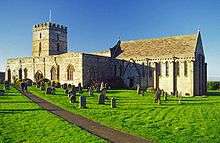Bamburgh
Bamburgh (/ˈbæmbərə/ BAM-bər-ə) is a village and civil parish on the coast of Northumberland, England. It had a population of 454 in 2001,[1] decreasing to 414 at the 2011 census.[2]
| Bamburgh | |
|---|---|
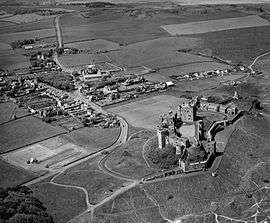 Bamburgh in 1973 | |
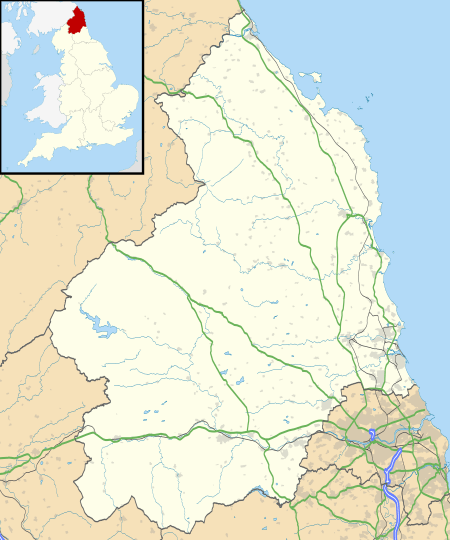 Bamburgh Location within Northumberland | |
| Population | 414 (2011) |
| OS grid reference | NU1734 |
| Civil parish |
|
| Unitary authority | |
| Ceremonial county | |
| Region | |
| Country | England |
| Sovereign state | United Kingdom |
| Post town | BAMBURGH |
| Postcode district | NE69 |
| Dialling code | 01668 |
| Police | Northumbria |
| Fire | Northumberland |
| Ambulance | North East |
| UK Parliament | |
The village is notable for the nearby Bamburgh Castle, a castle which was the seat of the former Kings of Northumbria, and for its association with the Victorian era heroine Grace Darling, who is buried there.
The extensive beach by the village was awarded the Blue Flag rural beach award in 2005. The Bamburgh Dunes, a Site of Special Scientific Interest, stand behind the beach. Bamburgh is popular with holidaymakers and is within the Northumberland Coast Area of Outstanding Natural Beauty.
History
The site now occupied by Bamburgh Castle was previously home to a fort of the Celtic Britons known as Din Guarie[3] and may have been the capital of the kingdom of Bernicia, the realm of the Gododdin people,[4] from the realm's foundation in c. 420 until 547, the year of the first written reference to the castle. In that year the citadel was captured by the Anglo-Saxon ruler Ida of Bernicia (Beornice) and became Ida's seat.[5]
The settlement was originally known as Bamburgh but became Bebbanburg (named after Saxon Queen Bebba) in 615 AD;[6] later in the 7th century, it was renamed Bamburgh. [7] Aidan of Lindisfarne came to this area from the monastery of Iona in 635 on behalf of King Oswald of Northumbria.
Following the defeat of Northumbrian forces by the Viking Great Heathen Army, at York in 867, the united Kingdom of Northumbria disintegrated. The limited evidence available suggests that north-east Northumbria – centred on the future County Durham, Northumberland and Lothian – remained an independent Anglo-Saxon kingdom, with Bamburgh its de facto capital. (During the late 9th and early 10th centuries, southern Northumbria was controlled by vikings in the form of the Danelaw, while north-west Northumbria became part of the late British kingdom of Strathclyde.)
The late medieval village began to develop near the castle.[8] During the Dissolution of the Monasteries the property of the friars, including the castle, were seized on behalf of Henry VIII.[9]
Late medieval British author Thomas Malory identified Bamburgh Castle with Joyous Gard, the mythical castle home of Sir Lancelot in Arthurian legend.[10]
St Aidan's Church
According to Bede, St Aidan built a wooden church outside the castle wall in AD 635, and he died here in AD 652. A wooden beam preserved inside the church is traditionally said to be the one on which he rested as he died.[11] The present church dates from the late 12th century, though some pre-conquest stonework survives in the north aisle. The chancel, said to be the second longest in the country (60 ft; 18m), was added in 1230; it contains an 1895 reredos in Caen stone by W.S. Hicks, depicting northern saints of the 7th and 8th centuries. There is an effigy of local heroine Grace Darling in the North Aisle. This formed part of the original Monument to Grace Darling but was removed due to weathering of the stonework. Her memorial is sited in the churchyard in such a position that it can be seen by passing ships.[12]
The property has been Grade I listed since December 1969. The listing summary includes this description:[13]
"Parish church. C12, C13 and C14. Restored 1830 and later C19. Squared stone and ashlar; chancel and north transept have stone slate roofs; other roofs not visible. West tower, nave, aisles, transepts and chancel".
Note that after the Dissolution of the Monasteries in the mid 1500s, the monks were forced to leave and St Aidan's became the parish church for the village. Over the subsequent centuries major repairs and restorations have been completed.[14][15] The church's crypt holds the remains of 110 individuals who died in the 7th and 8th century; they had originally been buried in the castle's Bowl Hole graveyard. The remains were found during a project between 1998 to 2007. Finally, in 2016, they were moved into the crypt. Since November 2019, the crypt can be viewed by visitors through a small gate.[16]
Governance
An electoral ward of the same name exists. This ward includes Belford and also stretches south to Ellingham with a total population taken at the 2011 census of 4,846.[17]
In popular culture
In literature, Bamburgh Castle, under its Saxon name Bebbanburg, is the home of Uhtred, the main character in Bernard Cornwell's The Saxon Stories.
Bamburgh is also featured in the open world video game series Forza Horizon 4 that was released in October 2018.
Notable people
- Æthelfrith of Northumbria
- William George Armstrong
- Joe Baker-Cresswell
- Ida of Bernicia
- Prideaux John Selby
- Grace Darling
- Uhtred the Bold
Photo gallery
 Bamburgh village and surroundings
Bamburgh village and surroundings Bamburgh seen from the castle
Bamburgh seen from the castle Grace Darling memorial in the churchyard
Grace Darling memorial in the churchyard The Grace Darling Museum, opposite the church
The Grace Darling Museum, opposite the church Crossroads in the village, looking towards the castle
Crossroads in the village, looking towards the castle Beach and castle, looking south
Beach and castle, looking south A map of Bamburgh from 1947
A map of Bamburgh from 1947
Bamburgh Lighthouse
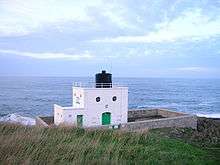 Bamburgh Lighthouse | |
 Northumberland | |
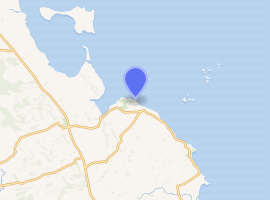
| |
| Location | Bamburgh, Northumberland, England |
|---|---|
| Coordinates | 55°36′59.6″N 1°43′27″W |
| Year first constructed | 1910 |
| Automated | 1910 |
| Construction | masonry building |
| Tower shape | parallelepiped building with lantern on the roof |
| Markings / pattern | white building, black lantern |
| Tower height | 9 m (30 ft) |
| Focal height | 12.5 m (41 ft) |
| Current lens | 1st order catadioptric fixed lens |
| Intensity | 7,140 candela |
| Range | white: 14 nmi (26 km) red and green: 11 nmi (20 km) |
| Characteristic | Oc (2) WRG 8s. |
| Admiralty number | A2810 |
| NGA number | 2252 |
| ARLHS number | ENG 004 |
| Managing agent | Trinity House[18] |
Bamburgh Lighthouse (also known as Black Rocks Point Lighthouse) was built by Trinity House in 1910 to guide shipping both passing along the Northumberland coast and in the waters around the Farne Islands. It was extensively modernised in 1975 and is now monitored from the Trinity House Operations and Planning Centre in Harwich. Routine maintenance is carried out by a local attendant. It is the most northerly land-based lighthouse in England.[19]
When originally built, the lamp was mounted on a skeletal steel tower (the footprint of which can still be seen within the compound) which stood alongside the white building which housed an acetylene plant to power the lamp.[20] (A similar arrangement can be seen today at Peninnis Lighthouse in the Isles of Scilly.) It was a sector light with a group occulting characteristic (showing two eclipses every 15 seconds).[21]
During electrification in 1975 the tower was removed, and the lantern was placed instead on top of the (now redundant) acetylene building.[19] Diesel generators were installed in the building; these were retained as a standby provision after 1980, when the lighthouse was connected to the mains.[22]
See also
- Bamburgh Coast and Hills, a Site of Special Scientific Interest along the coast north-east of Bamburgh
- List of lighthouses in England
References
- Neighbourhood Statistics. "Census 2001". Neighbourhood.statistics.gov.uk. Archived from the original on 13 June 2011. Retrieved 2 August 2012.
- "Parish population 2011". Archived from the original on 26 June 2015. Retrieved 25 June 2015.
- "Bernaccia (Bryneich / Berneich)". The History Files. Retrieved 18 June 2018.
- 'An English empire: Bede and the early Anglo-Saxon kings' by N. J. Higham, Manchester University Press ND, 1995, ISBN 0-7190-4423-5, ISBN 978-0-7190-4423-6
- The Anglo-Saxon Chronicle, entry for 547.
- Aethelfrith and Edwin 598AD-633AD
- Defensive Northumberland Chapter 3
- BAMBURGH HISTORY
- Skulldugerous Knight Sir John Forster
- Black, Joseph (2016). "The Broadview Anthology of British Literature: Concise Volume A - Third Edition". Broadview. p. 536. ISBN 978-1554813124.
- "St Aidan, Bamburgh". Retrieved 19 June 2018.
- Purves, Churches of Newcastle and Northumberland, Tempus, Stroud, 2006
- CHURCH OF ST AIDAN
- St Aidan's Church
- St Aidans Searching the Past
- Bamburgh crypt project celebrates area’s heritage
- "Parish Population 2011". Retrieved 25 June 2015.
- Bamburgh The Lighthouse Directory. University of North Carolina at Chapel Hill. Retrieved April 29, 2016
- "Bamburgh Lighthouse". Trinity House.
- Vintage postcard showing original arrangement.
- Potter, J. D. (1910). North Sea Pilot, Part III. London: The Admiralty (Hydrographic Office).
- Woodman, Richard; Wilson, Jane (2002). The Lighthouses of Trinity House. Bradford-on-Avon, Wilts.: Thomas Reed. p. 98.
- Chisholm, Hugh, ed. (1911). . Encyclopædia Britannica (11th ed.). Cambridge University Press.
External links
| Wikimedia Commons has media related to Bamburgh. |
- Bamburgh Photos
- Local History and Information on Bamburgh, The Farne Islands and surrounding areas.
- Stained glass windows at St. Aidan's Church, Photos by Peter Loud
- Bamburgh Tourist Attractions
- Bamburgh Online
- GENUKI (Accessed: 5 November 2008)
- Northumberland Communities (Accessed: 5 November 2008)
- Trinity House
